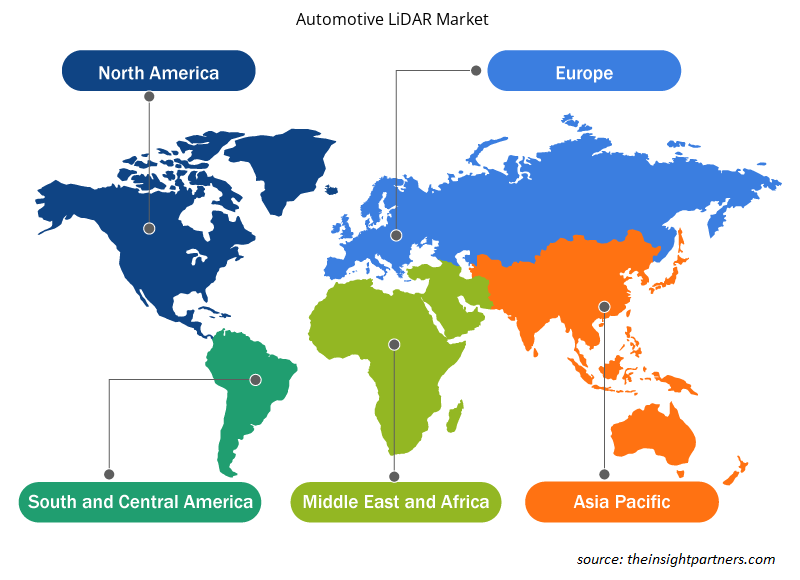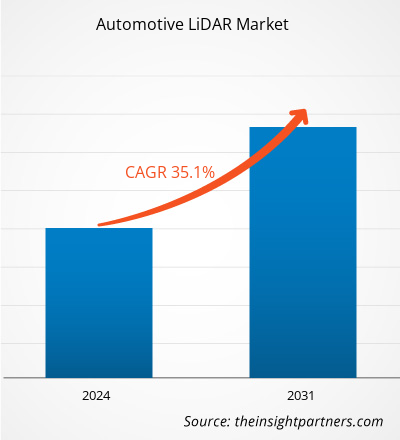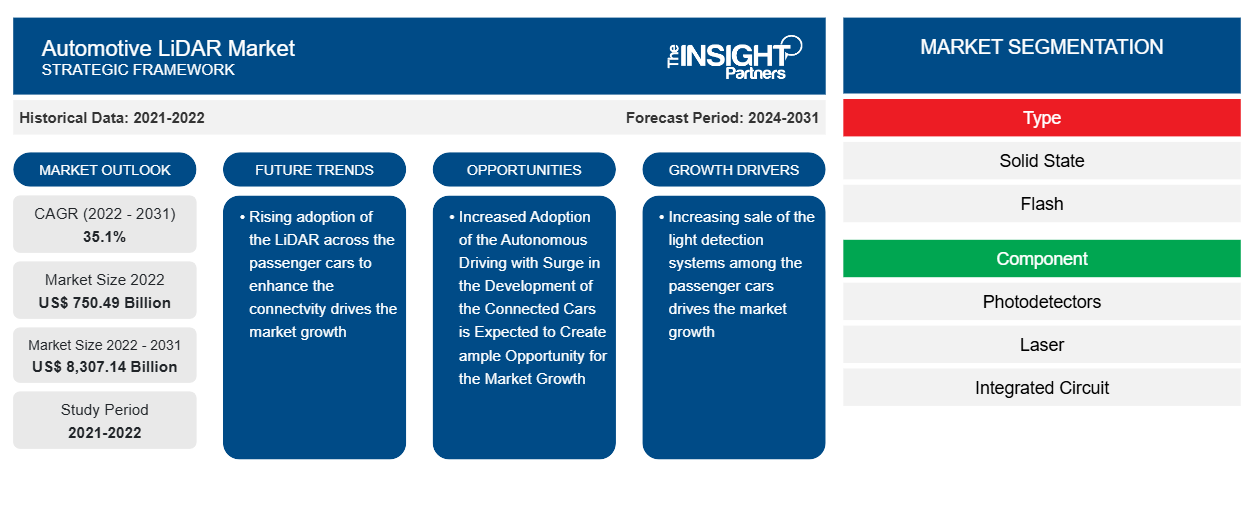Se proyecta que el tamaño del mercado de LiDAR automotriz alcance los 8.307,14 mil millones de dólares para 2031 desde los 750,49 mil millones de dólares en 2022. Se espera que el mercado registre una CAGR del 35,1% en 2022-2031. El mercado de LiDAR automotriz está impulsado por la rápida adopción de automóviles autónomos sin conductor junto con un aumento en la venta de automóviles conectados. Se espera que el mercado de conducción autónoma genere ingresos entre 300 mil millones y 400 mil millones de dólares para 2035. El aumento de la demanda de automóviles de pasajeros autónomos en los países desarrollados, incluidos EE. UU. y Canadá, impulsa el crecimiento del mercado de LiDAR automotriz. Además, el aumento de la demanda de automóviles de lujo en todo el mundo es un factor impulsor importante para el crecimiento del mercado de LiDAR automotriz durante el período de pronóstico.
Análisis del mercado de LiDAR automotriz
El mercado de LiDAR automotriz está impulsado por el aumento de las ventas de vehículos de lujo, junto con una mayor adopción de la tecnología ADAS en los vehículos, lo que impulsa el crecimiento del mercado de LiDAR automotriz durante el período de pronóstico. Se espera que el aumento del desarrollo de vehículos autónomos, junto con un aumento en las ventas de vehículos eléctricos construidos con tecnología LiDAR, creen oportunidades significativas para el crecimiento del mercado de LiDAR automotriz. Las empresas del mercado de LiDAR automotriz se centran en el desarrollo de nuevos productos y el lanzamiento de nuevos sensores basados en tecnologías autónomas . Por ejemplo, en enero de 2022, Innoviz Technologies Ltd. lanzó el sensor Innoviz360 de próxima generación en su línea de productos. Innoviz360 generó ingresos en 2023.
Descripción general del mercado de LiDAR automotriz
Se espera que la mayor adopción de vehículos autónomos apoye el crecimiento del mercado automotriz LiDAR. Las tecnologías automotrices y de vehículos conectados utilizan LiDAR para optimizar su uso. Los principales fabricantes de equipos originales, como Audi AG, BMW AG, Ford Motors, Mercedes-Benz, Nissan Corporation, Tesla Inc. y AB Volvo, ofrecen asistencia al conductor autónomo de nivel 2 a nivel mundial. Estos incluyen sistemas automotrices que ofrecen asistencia de aceleración, dirección y frenado mientras se conduce en autopistas. La penetración de los automóviles conectados con el aumento en la adopción de vehículos automatizados en el mundo real en las naciones desarrolladas, incluido el Reino Unido, los EE. UU. Y Alemania, impulsa el crecimiento del mercado automotriz LiDAR durante el período de pronóstico. Los servicios conectados en el automóvil ofrecen varios servicios, como mapas conectados, sistemas GPS y asistencia de transmisión de música basada en aplicaciones. Se proyecta que todos estos factores crearán amplias oportunidades para el crecimiento del mercado automotriz LiDAR durante el período de pronóstico.
Personalice este informe según sus necesidades
Obtendrá personalización en cualquier informe, sin cargo, incluidas partes de este informe o análisis a nivel de país, paquete de datos de Excel, así como también grandes ofertas y descuentos para empresas emergentes y universidades.
- Obtenga las principales tendencias clave del mercado de este informe.Esta muestra GRATUITA incluirá análisis de datos, desde tendencias del mercado hasta estimaciones y pronósticos.
Factores impulsores y oportunidades del mercado del LiDAR automotriz
Se espera que el aumento de las ventas de sistemas de detección de luz en los turismos sea el principal impulsor del mercado del lidar automotriz
El aumento de la penetración de los sistemas de detección de luz y el aumento de la penetración de las soluciones LiDAR avanzadas en los automóviles de pasajeros es un factor impulsor importante para el crecimiento del mercado de LiDAR automotriz durante el período de pronóstico. Además, la creciente demanda de automóviles autónomos y conectados, junto con el aumento de las asociaciones de los fabricantes de equipos originales de automóviles y otras organizaciones, también está generando un crecimiento significativo del mercado de LiDAR automotriz. El automóvil autónomo brinda comodidad a los pasajeros y mejora el nivel de seguridad de los viajeros. Estos vehículos autónomos ofrecen oportunidades lucrativas para que varias empresas automotrices accedan a una amplia gama de sensores y sistemas LiDAR autónomos para generar ingresos.
La adopción de tecnologías LiDAR automotrices ayuda a detectar la luz y a proporcionar tecnología de asistencia a la navegación para los propietarios de vehículos. Otro uso del LiDAR automotriz es en ADAS y LiDAR en servicios de robotaxis y viajes compartidos. La mayor demanda de servicios de alquiler de automóviles a pedido, servicios de transporte a pedido y movilidad como servicios son los principales factores impulsores del mercado LiDAR automotriz durante el período de pronóstico. Por lo tanto, los fabricantes de equipos originales automotrices están invirtiendo una cantidad considerable en sensores LiDAR para lanzar vehículos autónomos de próxima generación.
Se espera que la mayor adopción de la conducción autónoma con un aumento en el desarrollo de automóviles conectados cree una amplia oportunidad para el crecimiento del mercado.
Con el aumento del desarrollo económico a nivel mundial, existe la necesidad de tecnologías avanzadas para satisfacer el nivel de vida actual. La mayor adopción y el lanzamiento de la conducción autónoma y el aumento del crecimiento de los automóviles conectados impulsan el crecimiento del mercado mundial de LiDAR automotriz durante el período de pronóstico. Por ejemplo, en julio de 2023, el Grupo Volkswagen planeó lanzar vehículos autónomos de conducción autónoma para adoptar servicios de transporte compartido, transporte en automóvil y entrega de mercancías en los EE. UU. para 2026. Se espera que este crecimiento de la conducción autónoma por parte de los principales fabricantes de equipos originales cree amplias oportunidades para el crecimiento del mercado.
Análisis de segmentación del informe de mercado de LiDAR automotriz
Los segmentos clave que contribuyeron a la derivación del análisis del mercado LiDAR automotriz son el tipo, el componente y la aplicación.
- Según el tipo, el mercado mundial de LiDAR para automoción se divide en estado sólido y flash. Entre estos, el estado sólido tiene la mayor participación en 2023.
- Según los componentes, el mercado se divide en fotodetectores, láseres, circuitos integrados, elementos ópticos y otros.
- Según la aplicación, el mercado se divide en lanzaderas autónomas, robotaxis y automóviles de pasajeros. Entre estos, los automóviles de pasajeros tendrán la mayor participación en 2023, debido a la creciente adopción de tecnologías avanzadas por parte de los principales fabricantes de equipos originales, proveedores y proveedores de tecnología en todo el mundo.
Análisis de la cuota de mercado de LiDAR para automoción por geografía
El alcance geográfico del informe del mercado LiDAR automotriz se divide principalmente en cinco regiones: América del Norte, Europa, Asia Pacífico, Medio Oriente y África, y América del Sur.
Se proyecta que la región de Asia Pacífico tendrá la mayor participación en 2023 en el mercado de LiDAR automotriz durante el período de pronóstico. El crecimiento de esta región se debe principalmente a la rápida urbanización, el aumento de las ventas de automóviles y un aumento en la adopción de tecnologías avanzadas por parte de los principales fabricantes de equipos originales. Los países emergentes como India, China, Corea del Sur y Japón están creciendo a un ritmo rápido debido a la presencia de varios fabricantes de equipos originales automotrices líderes. Los fabricantes de equipos originales automotrices en la región de Asia Pacífico incluyen Hyundai Corporation, Kia Motors, Nissan Corporation, Honda Corporation y Toyota Corporation. Estos actores líderes están desarrollando automóviles autónomos automatizados para satisfacer la demanda de urbanización actual.
Perspectivas regionales del mercado de LiDAR automotriz
Los analistas de Insight Partners explicaron en detalle las tendencias y los factores regionales que influyen en el mercado de LiDAR automotriz durante el período de pronóstico. Esta sección también analiza los segmentos y la geografía del mercado de LiDAR automotriz en América del Norte, Europa, Asia Pacífico, Medio Oriente y África, y América del Sur y Central.

- Obtenga datos regionales específicos para el mercado de LiDAR automotriz
Alcance del informe de mercado de LiDAR automotriz
| Atributo del informe | Detalles |
|---|---|
| Tamaño del mercado en 2022 | US$ 750,49 mil millones |
| Tamaño del mercado en 2031 | US$ 8.307,14 mil millones |
| CAGR global (2022-2031) | 35,1% |
| Datos históricos | 2021-2022 |
| Período de pronóstico | 2024-2031 |
| Segmentos cubiertos | Por tipo
|
| Regiones y países cubiertos | América del norte
|
| Líderes del mercado y perfiles de empresas clave |
|
Densidad de actores del mercado de LiDAR automotriz: comprensión de su impacto en la dinámica empresarial
El mercado de LiDAR automotriz está creciendo rápidamente, impulsado por la creciente demanda de los usuarios finales debido a factores como la evolución de las preferencias de los consumidores, los avances tecnológicos y una mayor conciencia de los beneficios del producto. A medida que aumenta la demanda, las empresas amplían sus ofertas, innovan para satisfacer las necesidades de los consumidores y aprovechan las tendencias emergentes, lo que impulsa aún más el crecimiento del mercado.
La densidad de actores del mercado se refiere a la distribución de las empresas o firmas que operan dentro de un mercado o industria en particular. Indica cuántos competidores (actores del mercado) están presentes en un espacio de mercado determinado en relación con su tamaño o valor total de mercado.
Las principales empresas que operan en el mercado LiDAR automotriz son:
- Continental AG
- Delphi Automotriz
- Primer sensor AG
- Tecnologías Infineon AG
- Tecnologías Innoviz, Ltd.
- Tecnología Leddar, Inc.
Descargo de responsabilidad : Las empresas enumeradas anteriormente no están clasificadas en ningún orden particular.

- Obtenga una descripción general de los principales actores clave del mercado de LiDAR automotriz
Noticias y desarrollos recientes del mercado de LiDAR automotriz
El mercado de LiDAR automotriz se evalúa mediante la recopilación de datos cualitativos y cuantitativos posteriores a la investigación primaria y secundaria, que incluye publicaciones corporativas importantes, datos de asociaciones y bases de datos. A continuación, se incluye una lista de los desarrollos en el mercado de LiDAR automotriz y las estrategias:
- En abril de 2024, Luminar Technologies lanzó sensores de última generación en asociación con AB Volvo. Luminar Technologies lanzó el lidar Iris para su primer cliente global, AB Volvo. (Fuente: Flyability, comunicado de prensa/sitio web de la empresa/boletín informativo)
Cobertura y resultados del informe sobre el mercado de LiDAR automotriz
El informe “Tamaño y pronóstico del mercado de LiDAR automotriz (2021-2031)” proporciona un análisis detallado del mercado que cubre las siguientes áreas:
- Tamaño del mercado y pronóstico a nivel global, regional y nacional para todos los segmentos clave del mercado cubiertos bajo el alcance
- Dinámica del mercado, como impulsores, restricciones y oportunidades clave
- Principales tendencias futuras
- Análisis PEST detallado
- Análisis del mercado global y regional que cubre las tendencias clave del mercado, los principales actores, las regulaciones y los desarrollos recientes del mercado.
- Análisis del panorama de la industria y de la competencia que abarca la concentración del mercado, el análisis de mapas de calor, los actores destacados y los desarrollos recientes
- Perfiles de empresas detallados con análisis FODA
- Análisis histórico (2 años), año base, pronóstico (7 años) con CAGR
- Análisis PEST y FODA
- Tamaño del mercado, valor/volumen: global, regional y nacional
- Industria y panorama competitivo
- Conjunto de datos de Excel
Informes recientes
Testimonios
Razón para comprar
- Toma de decisiones informada
- Comprensión de la dinámica del mercado
- Análisis competitivo
- Información sobre clientes
- Pronósticos del mercado
- Mitigación de riesgos
- Planificación estratégica
- Justificación de la inversión
- Identificación de mercados emergentes
- Mejora de las estrategias de marketing
- Impulso de la eficiencia operativa
- Alineación con las tendencias regulatorias





















 Obtenga una muestra gratuita para - Mercado LiDAR automotriz
Obtenga una muestra gratuita para - Mercado LiDAR automotriz